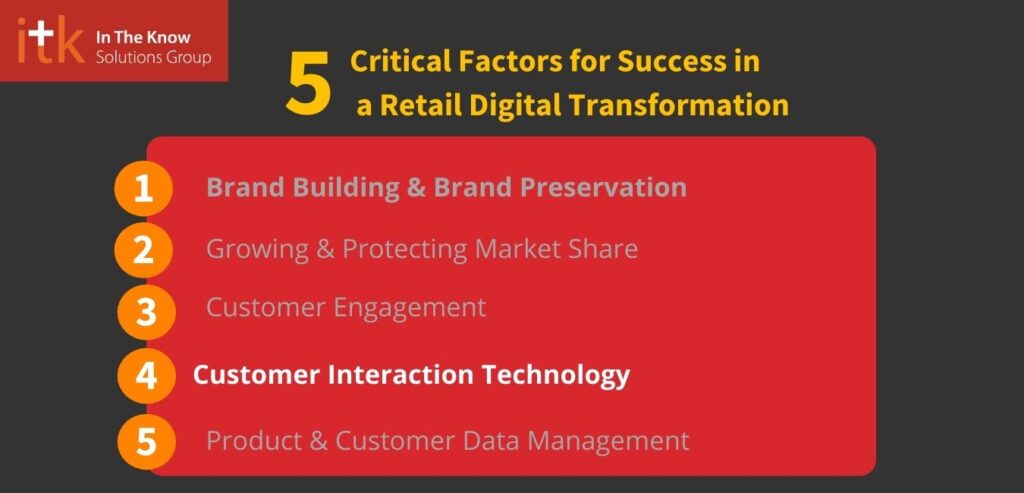Historically the default customer interaction for consumers has been stores sales associates. Recognizing this, successful store native retailers invested in providing excellent customer experiences by providing sufficient levels of staffing and giving sales associate the right tools and providing ongoing training in the art of service. Sadly, when faced with economic pressures, most retailers took the path of least resistance and identified these programs, and the people who staffed them as expendable. Unfortunately, what they did not consider were the negative impacts this short-term thinking had on maintaining a culture of service.
Customer Interaction Technology is one of the core elements in any Retail Digital Transformation that also includes, Brand Building and Brand Preservation, Growing and Protecting Marketshare, Customer Engagement and Product and Customer Data Management.
The net impact is that today consumers have become accustomed to having little to no interaction when they go out shopping. Consumers may be forced to endure this, but they refuse to accept it. Nordstrom’s is known to be the go-to retailer when shoppers are looking for personalized interaction be it the fitting of women’s shoes or a man’s suit. Other than this rare example, in-store customer interaction has become a spiritless, regurgitation of indifferent offers of assistance.
As Online shopping matured, digitally native retailers recognized that consumers still hungered for some level of interaction while shopping. These new retailers embraced this opportunity and created a more engaging experience as a core part of online shopping. Although online interactions do not involve a face-to-face encounter with a sales associate, the service offered still represented a marked improvement over the customer’s barren, in-store experience. Online retailers embraced the customer interaction challenge by utilizing technology creatively offering services and engagement previously unimagined by traditional retailers.
Responding to precipitously declining in-store sales, store native retailers recognized that their survival was dependent upon improving their shopping experience to be comparable to what was now available online. Management looked to technology to be their savior. They soon discovered that this strategy was woefully misguided. This was because they misdiagnosed their customer service deficiencies as a technology problem and not as a customer interaction problem. Sales continued to decline as they attempted to innovate under this false assumption.
Early on some retailers tried to address the customer interaction issue through the deployment of technology in the form of in-store kiosks to compensate for the absence sales associates on the sales floor. This was thought to represent an improvement over the customer wandering hopelessly looking for help. Customers though, have not found this to be a compelling improvement in service. In fact, far too many customers perceived this as being expected to do the job of the sales associate. Whether having to check a price at a kiosk or conducting the sales transaction at a service-less self-checkout, retailers continue to throw technology at the customer as a substitute for service.
Forward-thinking retailers recognized the fallacy of this approach and got down to the hard work of fixing the crisis brought on by poor customer satisfaction. Customer interaction technology, like all technology, must be tied to a strategic goal and its use must be consistent and strengthen operational processes to reinforce the brand’s culture of service in all customer interactions. The market is flooded with new technology tools each appearing to be the silver bullet of customer engagement. Novelty alone is fleeting: It ignores the fact that developing and maintaining a relationship with customers is hard work. Many of these applications have promise but only if they are deployed as a part of an overall customer engagement strategy.
Astute store native retailers recognized that they must be present in both the physical and virtual worlds. This presence offered the potential for the significant improvements essential for competitive customer interactions. Through technology-enabled integrated programs they capitalized on unique elements of both venues.
Best Buy stands as an example of a traditional retailer that reimagined the shopping experience where customer interaction technology played a key role in reversing their rapidly declining fortunes. At the onset of online shopping Best Buy went from being a solid performing big box retailer to customers de facto showroom to research products where they would then buy from online competitors at home. This transition occurred with head-snapping speed.
To do this, Best Buy developed and promoted their online shopping experience that provided a platform for consistent customer engagement. As a part of their new strategy Best Buy then recreated their stores to be showrooms intentionally and broadened their service offerings with the Geek Squad thus redefining the shopping experience. Best Buy created the “Blended Shopping Experience” by introducing services that web only online stores could not match. Customers now had a reason to come into the store, peruse and ask questions of the knowledgeable sales associates, then order from the Best Buy’s web store, arrange delivery, and set up services all in a single visit.
Another example of how retailers have raised the bar on customer engagement is the deployment of the capability to buy on-line and to pick up curbside by appointment. Both Walmart and Target realized that many customers prefer not to spend the time shopping in store. This preference is found in all Retail segments and is growing in popularity due to its convenience. Like Best Buy, these companies have found that success comes from reimagining the experience from the customer perspective. These retailers cast off the notion that all shopping had to be done on premises and within typical business hours. Instead, they embraced new virtual methods of offering service and convenience that previously had not existed. Importantly, this innovation was less about deploying new technology than it was realigning processes and existing technology to a new purpose.
Virtual Reality (VR), a technology that was only seen as entertainment has garnered a great deal of interest for its application to shopping. Once seen as a novelty with no real retail application, this technology has been put to great use in ways unimagined a few short years ago. As a part of consumer interaction strategy, customers could use this new capability to view products virtually whether they were shopping online or instore or conducting preliminary research prior to visiting a store. This technology has been used to great affect for products where previously the conventional wisdom said could only be sold in the physical reality of the store. VR has created a mulit-channel opportunity for whole segments of product categories and by doing so created a new capability for personalized customer interaction.
A great example of the use of VR is enhancing the process of furniture shopping and interior design. Once restricted to a shopping process restricted to a physical design showroom this new technology renders this thinking obsolete. Now, consumers can upload a picture of their home and continue the shopping process based on the rooms in their house. Rather than selecting furniture or furnishings based on memory alone customers can now superimpose products directly into their home virtually. Although most can see the use of this technology primarily as an online capability, this same application works perfectly while customers shop in store. Here technology creates a new opportunity for customer interaction for products and services irrespective of whether they are shopping online or instore. Most importantly, the capability to model infinite configurations mitigates the fear and anxiety often associated with more expensive purchases or products that cannot easily be returned.
Recently, retailers have deployed a capability for VR in the use of shopping for eyeglasses. This online capability allows customers to upload a picture of their face at which point styles can be tried on virtually. Once a final selection is made the shopper can upload their prescription and have their new eyeglasses crafted and sent to them directly. These are great examples of how technology can be utilized to entice consumers to engage in a shopping experience, one that is free from the restrictions of store hours and onsite inventory.
Store retailers have long looked at the checkout process as a rich opportunity to improve customer service. As noted earlier, asking customers to check themselves out has not been warmly embraced as a positive experience. Many retailers have pivoted to mobile Point of Sale (MPOS) as the new silver bullet to providing excellent customer experience. The fallacy is that mobile POS is utilized as nothing more than a register without cords for line busting during peak sales activities. For many retailers the result has been that these devices languish unused in their chargers in the back room until peak selling periods only to find that they are out of date or sales associates don’t remember the training that they once received. What has been missing all along is determining how to utilize the power of these devices as a customer interaction tool and not just as an occasional emergency register.
The reason deployment of mobile POS devices never deliver on improved customer engagement has nothing to do with technology, but everything to do with the company’s customer engagement strategy of which the mobile POS device should be but one element. Beyond line busting the mobile device can be a powerful engagement facilitator that should include lifestyle galleries, product information, price lookup, inventory lookup, brand information, and the ability to translate all of this into multiple languages and currencies. Fully enabled, the sales associate would be empowered to lookup a customer’s activity and preferences on the mobile POS device to have a genuine exchange grounded in their individual purchase history inclusive of all channels.
Many of these initiatives fail because of their narrowness of vision. Too many retailers see the deployment of mobile POS as a technology driven initiative rather than a customer centric exercise of corporate transformation. Retailers need to reorient themselves around the needs of the customer and the customer engagement process and not the needs of their own functional silos. They cannot defer or default to IT to deliver business value and operational transformation. The responsibility lies with the organization in total. It is incumbent upon the functional groups to articulate the strategy and participate in the development and delivery of the solution.
The golden rule for successful customer interactions is the benefit to the customer must define the technology capabilities. The degree to which this is followed or not, ultimately determines how successful interactions with customers will be. This further determines loyalty, futures sales, and lifetime value of each customer. In short, retailer’s success hinges upon putting the customer forward, not technology forward. The great promise that customer interaction technology holds can never be fully realized if retailers fail to keep the customer’s needs satisfied. Technology alone cannot produce customer satisfaction.
What’s Next?
To succeed in this changing landscape, store-native retailers will need to abandon their legacy habits and start acting like their digital-native competitors. We’ve created a guide for having crucial discussions about Digital Transformation with leadership, including a big picture perspective that outlines why these projects are about survival, not just technology. And a visual roadmap to help guide these conversations, outline the current state of retail and tips on succeeding in this new environment. You can download this guide/whitepaper we call, “Retail Transformation Imperatives: 5 Imperatives for Retailers, Wholesalers and Brands.” A how to manual for navigating the ever-evolving retail world, and a blueprint for success in the new era of commerce.






